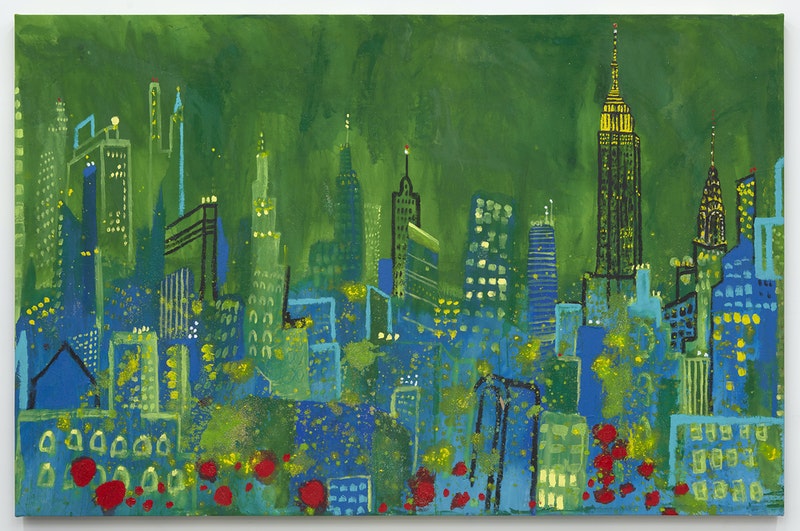April 6, 2022
Download as PDF
View on The Brooklyn Rail

Tabboo!, Big Green Manhattan Skyline, 2021. Acrylic and glitter on canvas, 72 1⁄2 × 111 1⁄4 inches. Courtesy the artist, Karma, and Gordon Robichaux
Tabboo!, legendary for his drag performances in the eighties on the Lower East Side, is showing recent cityscapes at Karma’s two sites, located in the East Village where the artist still lives, and at Gordon Robichaux. Residing in his walkup apartment, Tabboo! continues to work at a hectic pace, as these shows demonstrate. Painted roughly, often with a bright palette, the cityscapes are the artist’s way of celebrating his long love for New York. The city’s architecture, not overly known for its attractiveness, here receives a visionary treatment. As an extended portrayal of buildings throughout our urban environment, the shows pay homage to the backdrop in which Tabboo! performed and still lives. The works themselves, given to a loose realism, celebrate the individual constructions that make up the skyline. The paintings as well establish the artist’s presence in New York’s long-recognized support for experimental art, in which Tabboo! played a noted role. Thus, the exhibitions are paying homage not only to current work but also to an exciting alternative scene that took place two generations ago, in a neighborhood now gentrified.
Spring NYC (2020) looks at the city as a site of luminous color; pink, bright mauve, purple, yellow, and red suffuse the intermittent forms of tall buildings. A couple of structures are outlined in black on the left and right of the painting; at the bottom, in the center, is a building with a pinkish grid of windows. Some drips fall downward from the top of the painting. Certainly the colors do not truly match the actual color of the buildings; instead, Tabboo! presents us with the enthusiasm of spring, a new season still livable before the great heat of a New York summer. The buildings, freely described, act as vehicles for brilliant color. The artist captures the density of the (unnamed) area and the linear cast of the buildings extremely well. Looking North Union Square (2021), made with acrylic and glitter, looks like a painting done during late twilight; the upper sky is a dark gray. The left side of the painting includes two buildings rendered in a luminous blue, one with a sharply angled roof and the other with a grid of windows. The heights of the Chrysler Building, given a deep gray, dominate that side of the composition. On the right, we see darker buildings, colored black, dark blue, and brick red, but a bright yellow pyramidal structure occurs, as well as a building in white in the background. A traffic light with a curved support moves left from the right edge of the painting.
In Big Green Manhattan Skyline (2021), the jumble of slightly crooked buildings and the sky are painted either a dark green or brighter, more luminous one (in the center of the paintings, some buildings are painted in a bright blue). Windows are presented as yellow spots, while at the bottom of the painting, bright red circles follow its edge, contrasting well with the dominant greens. Yet it is hard to comprehend the red spheres’ architectural meaning. Tabboo! employs an expressionist style in his freely given cityscapes, which he reads as a city half in decline, half in new construction. His paintings are joyous and free. Knowing Tabboo!’s long-standing presence in the city as a performance artist and painter, we appreciate his current reading of New York—it remains a center for making art despite increasing gentrification: the tall, anonymous apartment buildings now found throughout the city. Tabboo! is not eulogizing the city in these portraits; rather, he is recording its disparate structures as he tries to keep the spirit of New York alive. His activities are memorable both early and late in his career.



